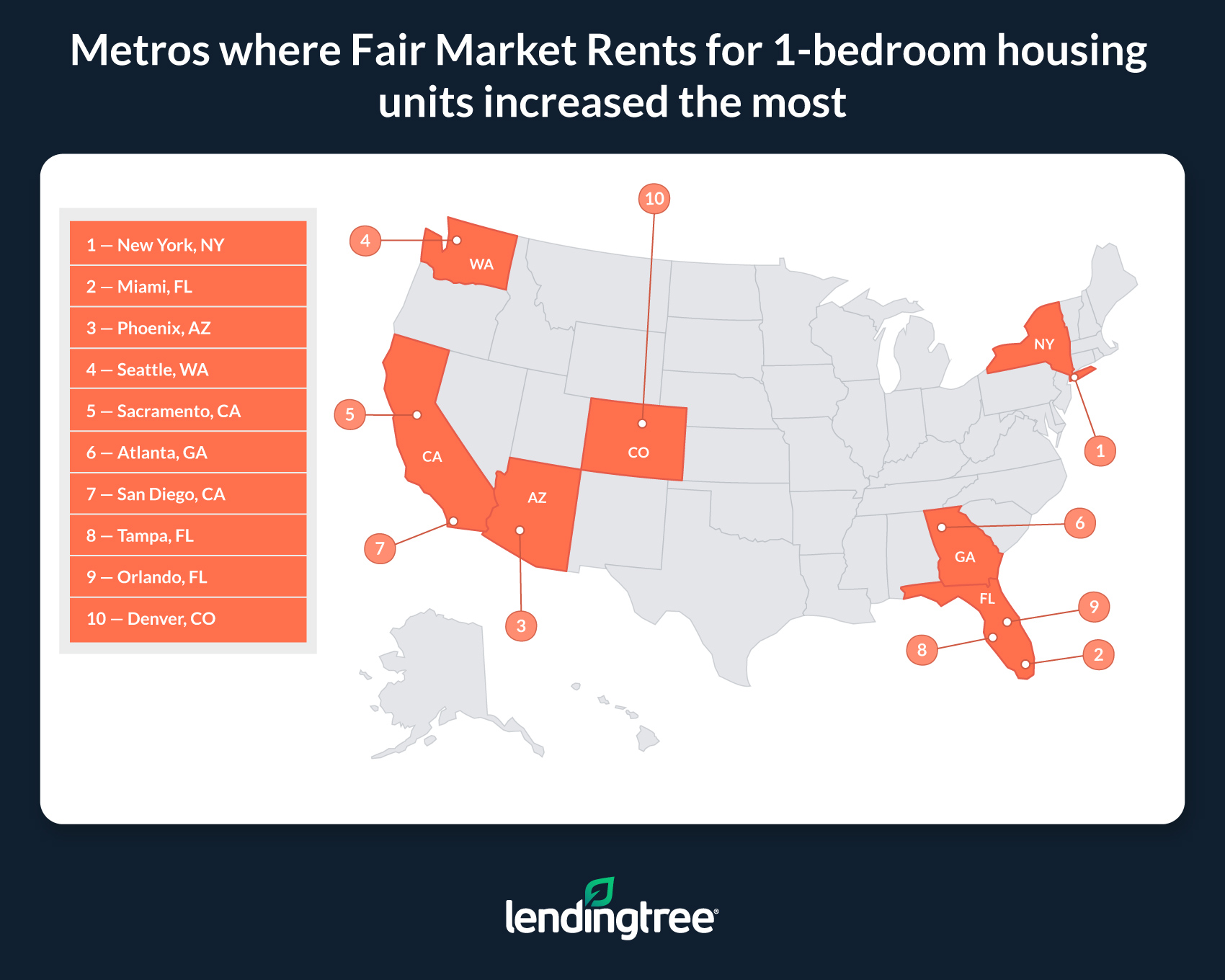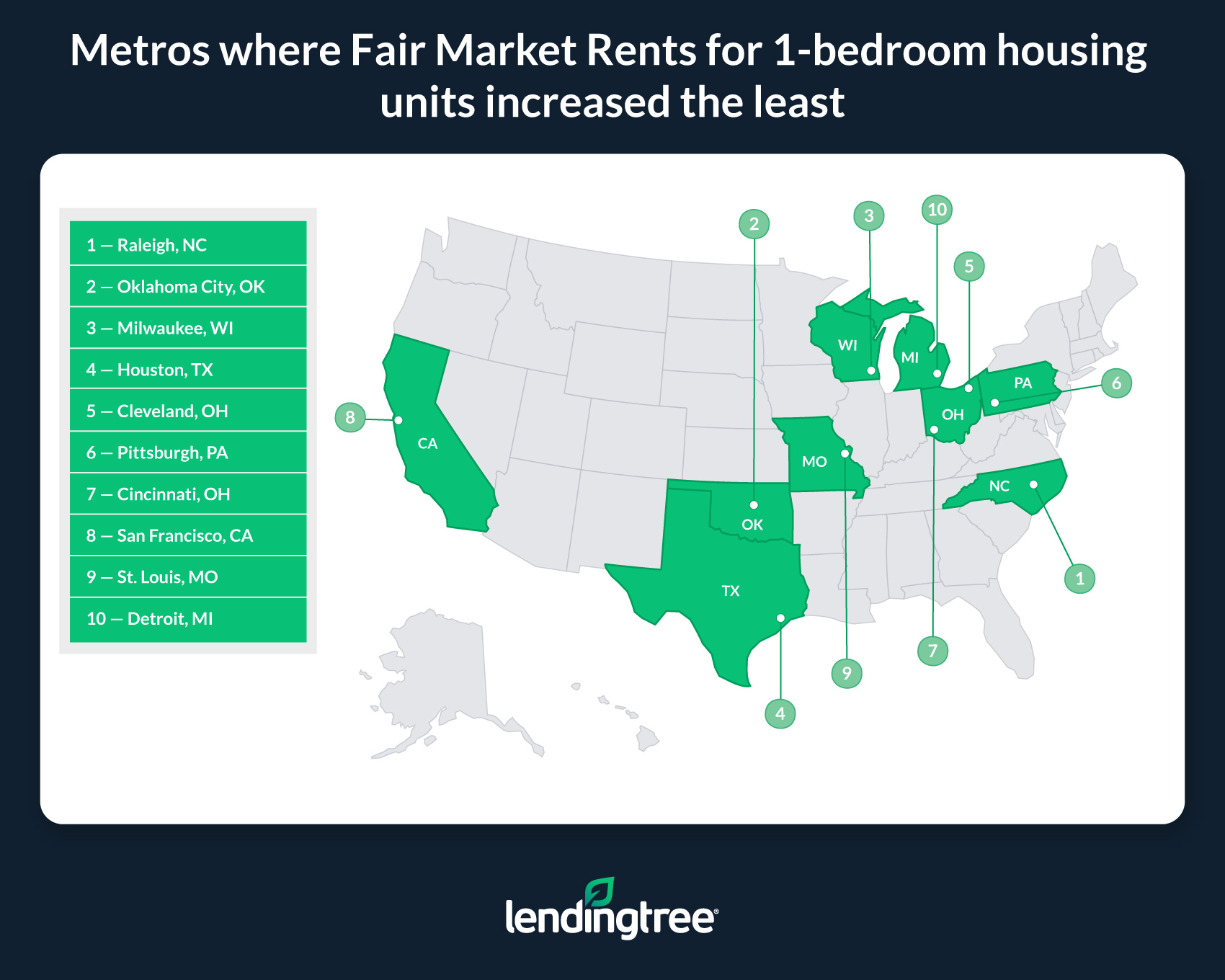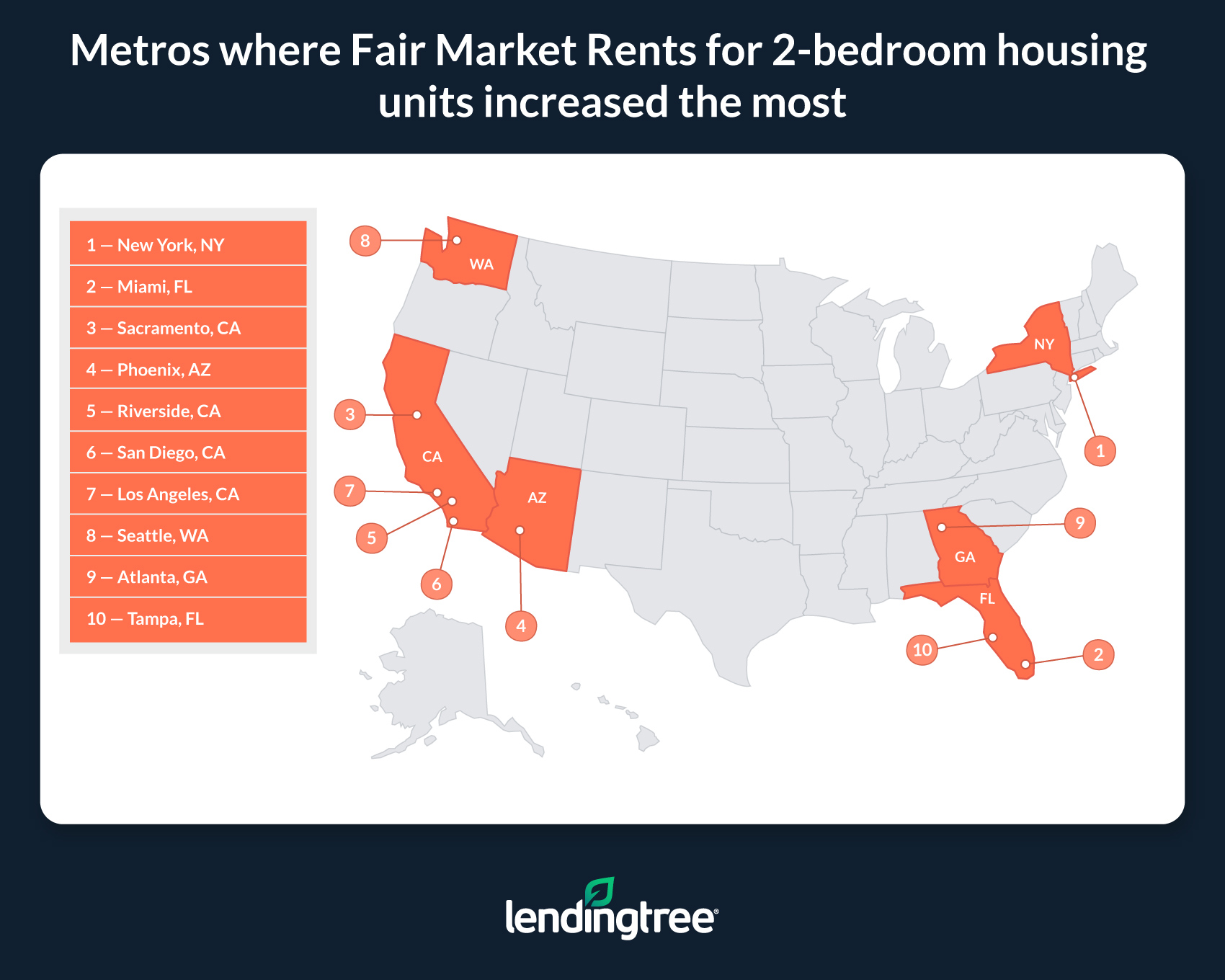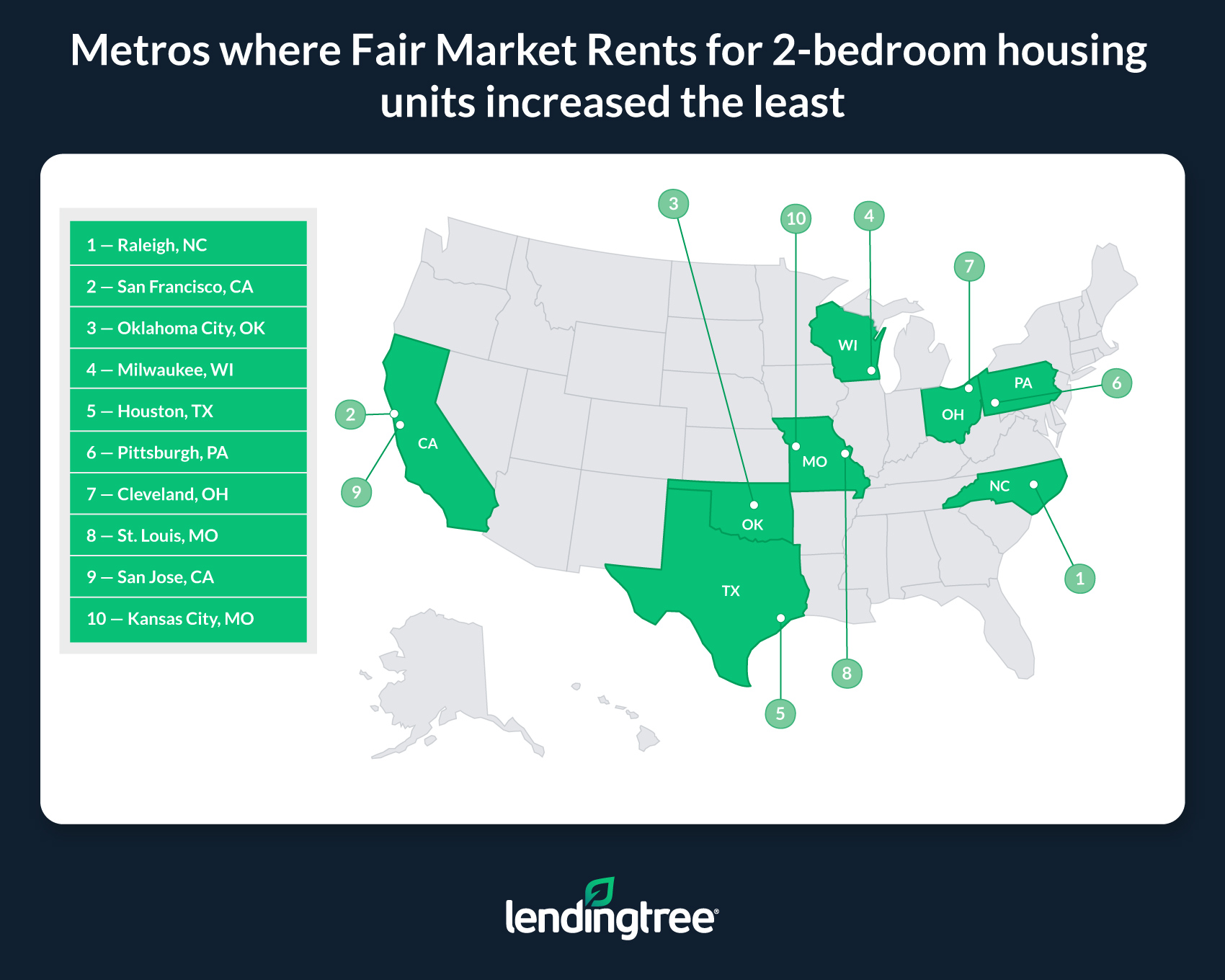Fair Market or Foul Play? Fair Market Rents Have Risen Dramatically Since 2019
Though renting remains cheaper than buying, rents have increased significantly over the past few years. This is especially true in many large metropolitan areas where already steep housing costs have climbed even higher.
To illustrate how much rents have risen, LendingTree utilized U.S. Department of Housing and Urban Development (HUD) data to calculate changes in Fair Market Rents The U.S. Department of Housing and Urban Development (HUD) defines Fair Market Rents as “estimates of 40th percentile gross rents for standard quality units within a metropolitan area or nonmetropolitan county.” (FMRs) for one- and two-bedroom housing units in each of the nation’s 50 largest metros from 2019 to 2024.
Read on to learn how FMRs have changed in recent years.
Key findings
- In each of the nation’s 50 largest metros, Fair Market Rents for one- and two-bedroom housing units grew from 2019 to 2024. On average, FMRs for one- and two-bedroom units grew by $450 and $505, respectively.
- FMRs for one-bedroom units increased by the largest dollar amounts in New York, Miami and Phoenix. In these metros, FMRs for one-bedroom homes rose by $852, $737 and $731, respectively, from 2019 to 2024. Of note, metros with the most FMR growth aren’t necessarily the most expensive areas in the country. For instance, New York’s one-bedroom FMR for 2024 is $2,451, $367 lower than San Francisco, ranked 43rd for one-bedroom FMR growth.
- One-bedroom FMRs increased by the lowest dollar amounts in Raleigh, N.C., Oklahoma City and Milwaukee. At $61, Raleigh is the only metro in our study where the FMR for a one-bedroom unit didn’t increase by more than $100 from 2019 to 2024. Oklahoma City and Milwaukee saw increases of $195 and $226, respectively.
- FMRs for two-bedroom units grew the most in New York, Miami and Sacramento, Calif. In these metros, From 2019 to 2024, they increased by $921, $870 and $852, respectively.
- Raleigh, San Francisco and Oklahoma City saw FMRs for two-bedroom units increase the least from 2019 to 2024. Raleigh saw an increase of $181, while San Francisco and Oklahoma City saw jumps of $189 and $224. In the same way a large dollar increase in a metro’s FMR doesn’t necessarily mean it’s the most expensive area, a more modest increase doesn’t mean an area is cheap. Despite a relatively small increase from 2019, the 2024 FMR for a two-bedroom in San Francisco is the highest in the nation at $3,359.
Metros where Fair Market Rents for 1-bedroom housing units increased the most
No. 1: New York
- 2024 Fair Market Rent for one-bedroom housing unit: $2,451
- 2019 Fair Market Rent for one-bedroom housing unit: $1,599
- Dollar change in Fair Market Rent, 2019 to 2024: $852
- Percentage change in Fair Market Rent, 2019 to 2024: 53.28%
No. 2: Miami
- 2024 Fair Market Rent for one-bedroom housing unit: $1,884
- 2019 Fair Market Rent for one-bedroom housing unit: $1,147
- Dollar change in Fair Market Rent, 2019 to 2024: $737
- Percentage change in Fair Market Rent, 2019 to 2024: 64.25%
No. 3: Phoenix
- 2024 Fair Market Rent for one-bedroom housing unit: $1,599
- 2019 Fair Market Rent for one-bedroom housing unit: $868
- Dollar change in Fair Market Rent, 2019 to 2024: $731
- Percentage change in Fair Market Rent, 2019 to 2024: 84.22%

Metros where Fair Market Rents for 1-bedroom housing units increased the least
No. 1: Raleigh, N.C.
- 2024 Fair Market Rent for one-bedroom housing unit: $711
- 2019 Fair Market Rent for one-bedroom housing unit: $650
- Dollar change in Fair Market Rent, 2019 to 2024: $61
- Percentage change in Fair Market Rent, 2019 to 2024: 9.38%
No. 2: Oklahoma City
- 2024 Fair Market Rent for one-bedroom housing unit: $884
- 2019 Fair Market Rent for one-bedroom housing unit: $689
- Dollar change in Fair Market Rent, 2019 to 2024: $195
- Percentage change in Fair Market Rent, 2019 to 2024: 28.30%
No. 3: Milwaukee
- 2024 Fair Market Rent for one-bedroom housing unit: $979
- 2019 Fair Market Rent for one-bedroom housing unit: $753
- Dollar change in Fair Market Rent, 2019 to 2024: $226
- Percentage change in Fair Market Rent, 2019 to 2024: 30.01%

Metros where Fair Market Rents for 2-bedroom housing units increased the most
No. 1: New York
- 2024 Fair Market Rent for two-bedroom housing unit: $2,752
- 2019 Fair Market Rent for two-bedroom housing unit: $1,831
- Dollar change in Fair Market Rent, 2019 to 2024: $921
- Percentage change in Fair Market Rent, 2019 to 2024: 50.30%
No. 2: Miami
- 2024 Fair Market Rent for two-bedroom housing unit: $2,324
- 2019 Fair Market Rent for two-bedroom housing unit: $1,454
- Dollar change in Fair Market Rent, 2019 to 2024: $870
- Percentage change in Fair Market Rent, 2019 to 2024: 59.83%
No. 3: Sacramento, Calif.
- 2024 Fair Market Rent for two-bedroom housing unit: $2,072
- 2019 Fair Market Rent for two-bedroom housing unit: $1,220
- Dollar change in Fair Market Rent, 2019 to 2024: $852
- Percentage change in Fair Market Rent, 2019 to 2024: 69.84%

Metros where Fair Market Rents for 2-bedroom housing units increased the least
No. 1: Raleigh, N.C.
- 2024 Fair Market Rent for two-bedroom housing unit: $925
- 2019 Fair Market Rent for two-bedroom housing unit: $744
- Dollar change in Fair Market Rent, 2019 to 2024: $181
- Percentage change in Fair Market Rent, 2019 to 2024: 24.33%
No. 2: San Francisco
- 2024 Fair Market Rent for two-bedroom housing unit: $3,359
- 2019 Fair Market Rent for two-bedroom housing unit: $3,170
- Dollar change in Fair Market Rent, 2019 to 2024: $189
- Percentage change in Fair Market Rent, 2019 to 2024: 5.96%
No. 3: Oklahoma City
- 2024 Fair Market Rent for two-bedroom housing unit: $1,091
- 2019 Fair Market Rent for two-bedroom housing unit: $867
- Dollar change in Fair Market Rent, 2019 to 2024: $224
- Percentage change in Fair Market Rent, 2019 to 2024: 25.84%

Building more housing units can help lower rents
A major reason rents have increased so dramatically in recent years is a lack of housing on the market.
Because price is usually based on the relationship between a given good’s supply and its demand, goods like rental units tend to become more scarce and expensive when demand increases faster than supply.
With fewer choices, renters have less wiggle room to negotiate with landlords for a better deal. In that same vein, landlords are less incentivized to lower prices because they don’t need to worry as much about being undercut by competition. Put simply, renters in markets with too little supply often have to choose between acquiescing to a landlord’s demands or going without a home. As a result, they can pay relatively steep prices.
Of course, the above explanation is simplified. The relationship between supply and demand can be fuzzy, and there are instances where prices may rise even as supply increases and demand drops. Moreover, even in housing markets with a lot of supply, not everyone will be able to negotiate their housing costs effectively.
Nonetheless, new construction remains an effective way to help rein in high housing costs.
Tips for renters
Whether they plan on renewing an expiring lease or hunting for a new place to call home, the following tips can help renters save money and keep their housing costs in check.
- Budget. By outlining your income and expenses, you can determine how much you can afford to spend on rent and decrease your odds of becoming house poor. A well-crafted budget can also give you a better sense of where your money is going and help you cut back on unnecessary spending. That said, a budget is only helpful if you stick to it. If you spend time crafting one, be sure it’s realistic and maintainable.
- Negotiate. In the same way you may be able to negotiate the price of a home for sale, you might also be able to negotiate rent. Landlords can be open to discussing terms, especially in competitive markets. By highlighting characteristics such as a strong credit score, a history of making payments on time and being willing to do things like sign a longer-term lease, you might be able to get a landlord to give you a discount.
- Consider alternatives. While renting is usually cheaper than buying in the short term, purchasing a house might still be more affordable than it seems. Strategies like shopping around for a lower rate on a mortgage can notably decrease the amount of money you’d need to spend on monthly housing costs and give you more options when choosing whether you want to rent or buy. If you’re on the fence, our rent versus buy calculator can help you better visualize the short- and long-term costs you’d incur.
Methodology
Fair Market Rent data in this study comes from the U.S. Department of Housing and Urban Development (HUD).
HUD defines Fair Market Rents as “estimates of 40th percentile gross rents for standard quality units within a metropolitan area or nonmetropolitan county.” More specifically, Fair Market Rents look at the monthly contract rent (or the monthly rent payment specified by a lease) and utility costs paid by those who moved into their home in the last 15 to 22 months. FMR calculations exclude rents charged for public housing units and units built within the past two years.
To be transparent, FMRs aren’t meant to provide an all-encompassing view of rents in a given area. As outlined, they look at a specific subset of housing units. Nonetheless, FMRs offer a useful benchmark for gauging rents in a given area, and looking at how they’ve changed over time can shed light on how the broader rental market is behaving.
